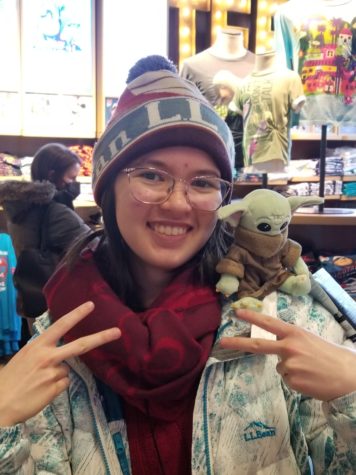Bee and Puppycat review: stupefied in space
January 19, 2023
Watching the animated Netflix series Bee and Puppycat is like trying to go scuba diving in a fever dream: you can tell there are unimaginable depths of beauty waiting to be explored, and yet before you can see anything a talking fish slaps you in the face and wakes you up.
Bee and Puppycat centers on Bee, a perennially unemployed woman who stumbles upon a mysterious alien creature called Puppycat, as well as their episodic adventures in outer-space temp work that follow.
The concept first hit the Internet in 2013 in the form of a pilot episode by Natasha Allegri. A full season of 10-minute episodes (totaling 1 hour) was later hosted on Cartoon Hangover’s YouTube channel from 2014 through 2016 following a wildly successful Kickstarter funding campaign.
A second season was planned to release on the streaming platform VRV in 2019, but languished in production purgatory–and was even leaked online at some point–until Netflix finally picked up the license and released it in September of 2022, compressing the plot of the original YouTube series into three “rebooted” episodes at the beginning of its new version, known as Bee and Puppycat: Lazy in Space.
This woefully confusing production timeline is the likely culprit for the confusion in the show itself. While the Netflix version does improve upon the already-adorable art of the original, with gorgeous color schemes and backgrounds that are pure eye candy, the pacing is almost whiplash-inducing: one minute the characters are standing around talking about eggs, and the next their lives are being threatened by gigantic disembodied hands.
While it’s important to recognize that this is a slice-of-life show, and thus unfair to expect heavily plot-driven episodes, the little that does happen is often plain disjointed and nonsensical. Infuriatingly, the show leaves many unanswered questions and hints of a much deeper plot, yet prefers to spend most of its time leading the characters around in circles.
It feels like the show is trying to be quirky and deep at the same time, and it succeeds in neither–it’s impossible to tell if the voice acting is unnatural and awkward on purpose, but either way it becomes grating very quickly. The charm and offbeat humor of the original is almost completely absent from the reboot, making it feel like a pale imitation that forgot its heart at home, despite its shiny new coat of paint.
Even so, most of the characters manage to be endearing in spite of their often-baffling dialogue, and the bizarre plot is compelling in an extremely frustrating way: you’ll want to keep watching just to figure out what could possibly be going on.
Of course, it’s entirely possible that I’m just the wrong audience for this kind of show, or that I missed the subtlety of the deeper plot. I can see why it was well received by general audiences, even if it left me wanting to punch a pillow in frustration.
All in all, I would recommend Bee and Puppycat: Lazy in Space if you’re looking for a show that lets you turn your brain off and just enjoy the absurdity. Otherwise, it may be better for your sanity to stick with the YouTube version.




